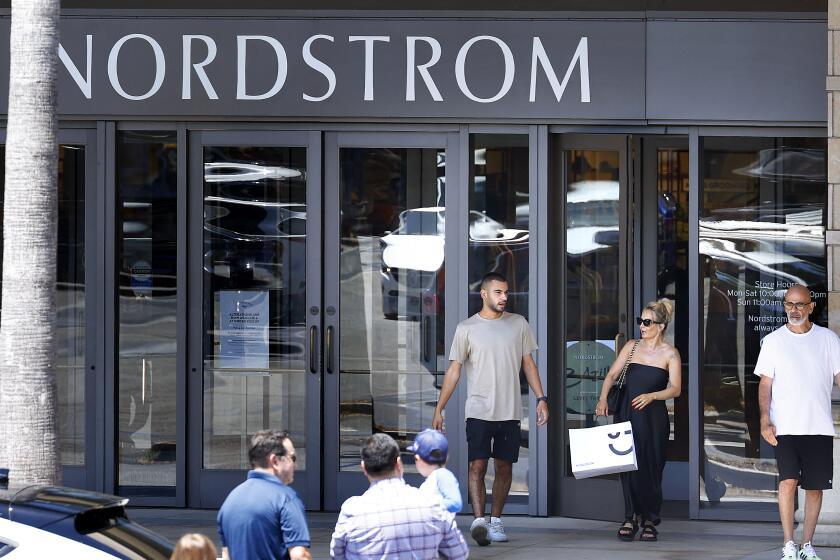‘88 Minimum Wage Increase Is Welcomed by Employees
- Share via
Maria Hovsepian, who spends her days hanging clothes on racks and showing customers to dressing rooms, says she earns every penny of the $4 an hour she makes as a clerk at a Santa Ana apparel store.
And she firmly believes she’s worth every cent of the raise she was voted last month.
Hovsepian, 20, is one of the estimated 600,000 lowest-paid Californians whose wages will go up as a result of the Dec. 19 decision by the state Industrial Welfare Commission.
Breaking with federal minimum-wage standards for the first time in a decade, the commission voted to increase the state’s minimum hourly wage for most workers by 90 cents, to $4.25. The last increase was in 1981, when the minimum was raised from $3.10 to $3.35.
“It’s excellent!” Hovsepian said of the raise, her enthusiasm dampening only when she was reminded that it does not take effect until July 1. Hovsepian, who is living with her aunt and uncle in Santa Ana while she attends trade school, said the pay she gets at the ClothesTime store where she works is her only income.
Preparations for Increase
Although the Industrial Welfare Commission’s decision does not take effect for six months, Orange County businesses and workers have already begun preparing for the new minimum wage, the highest in the nation.
Many people in the service industries that employ the most minimum-wage workers--restaurants, motels and retail stores among them--say the raise simply reflects economic reality after six years of inflation. The 3-2 commission vote increased by 27% a $3.35 minimum wage that had lost 28% of its buying power since it was established.
Hovsepian’s supervisor, store manager Kristen Jensen, agreed that clerks such as Hovsepian are entitled to the increase.
“People work hard for $3.35 an hour,” Jensen said, “and they deserve a raise. With a growing economy, $3.35 is peanuts.”
And even the president of the 181-store ClothesTime chain, Norman Abramson, saw a plus in a wage hike, though he said it will cost his firm millions of dollars. Although he had opposed the raise and had said that some employee hours would be cut as a result, Abramson said: “We hope that a lot of the young ladies we employ part-time will spend part of their money buying clothing.”
The change in the minimum wage will affect all workers 18 and older, except employees who receive more than $60 a month in tips. The minimum hourly rate for those workers will increase to $3.50.
California law requires that the minimum wage be “adequate to supply the necessary cost of proper living,” and both the Legislature and the Industrial Welfare Commission have long held the authority to increase the rate above federal levels. In 1916, 22 years before the adoption of a federal rate, California set its first minimum wage at 16 cents an hour for women and minors.
The Legislature did adopt a $4.25 rate earlier in 1987, but Gov. George Deukmejian vetoed the increase, saying the five commissioners he appointed should make the decision.
The commissioners, who met in San Francisco to vote on the issue, had only a general idea of how many California workers would be affected by the increase.
The commission’s executive officer, Karla M. Yates, said commissioners relied on studies from other agencies that estimated the number of minimum-wage workers at between 300,000 and 600,000 statewide. Californians earning less than $5 an hour were estimated at roughly 1.8 million, said Jack Hailey, a consultant with the state Senate Office of Research, which compiled one of the reports used by the commission.
Low-Pay Industries
There are no firm figures on which industries pay minimum wages, but Hailey said most low-paid workers are “in retail trade, restaurants, hotels and some still in agriculture, although not as many as there were.”
Hailey said the figures are loose at best. “Looking at the minimum wage is an inexact science,” he said.
Officials such as Hailey and Yates have few reliable economic models with which to predict the effect of the rate increase.
But employers who will see their labor costs rise and workers who expect to get a raise had some definite views on the subject.
With her son now nearly 2 years old, Michelle Reese has had time to work at a Santa Ana Bob’s Big Boy restaurant for extra money.
As a waitress, Reese, 19, will see her $3.35 hourly wage jump by 15 cents--an increase that she said is not enough.
Agrees on Lower Rate
Reese agreed that employees who receive tips should have a lower rate than other workers, but she complained: “A lot of people don’t tip when they should. Sometimes people would tip us a quarter for an $8 meal.”
She said that she has been working at Bob’s for five months and that her income there supplements that of her husband, a construction worker.
Many employers say the wage increase is long overdue, and one said it would help her find qualified employees.
With her husband, Pattie Jackson manages a Motel 6 in Anaheim. She said that she had trouble finding help for $3.35 an hour but that company policy sets wages for many positions at the legal minimum.
“This is going to be great for us,” she said. “We’re going to be able to get people more easily.”
Jackson said her employees, many of whom are immigrants from Mexico, deserve the raise.
“I was so glad to see it go up,” she said. “My girls and my maintenance guy work hard for us and do everything we need them to and never complain about their salaries. It really tickled me to see them get a boost.”
Some industries that traditionally have relied on minimum-wage workers have found it increasingly difficult to find employees to work for the lowest rate.
Patrick Flynn, a spokesman for Anaheim-based Carl Karcher Enterprises Inc., which owns the Carl’s Jr. restaurant chain, said many of his firm’s outlets already start workers at $4 an hour or more.
Expect to Raise Prices
Still, he said, the wage increase could affect 12,000 Carl’s Jr. employees statewide, 1,800 of them in the company’s 60 Orange County restaurants. As a result, Flynn said, the chain expects to raise its prices slightly.
ClothesTime’s president, Abramson, whose company has 27 outlets in Orange County, estimated that up to 1,400 of his employees statewide, and roughly 220 in Orange County, would receive raises because of the increase. All 181 ClothesTime stores are in California.
That will cost ClothesTime “a couple of million bucks on an annualized basis,” Abramson said, and as a result employee hours may be reduced.
His company has yet to decide how it will adjust to the wage increase, Abramson said, but “we’ll have to be tougher business people . . . the bottom line is that those who still have their jobs will be paid more, but others will lose their jobs.”
“I don’t really buy the argument that $3.35 an hour is below subsistence,” Abramson said, noting that most of his low-paid employees are students who work part-time and are not family breadwinners. He conceded, however, that for those who must support their families on low wages, a minimum rate might be preferable to welfare payments.
“From my viewpoint,” he said, “I don’t see what minimum-wage laws really do for us as a society. The market should be the market,” he said, and employers should have to pay only what that market will bear, not a minimum rate imposed by the state.
Abramson said he didn’t accept the argument that six years without a minimum wage increase was long enough.
“Who says the $3.35 minimum wage was the right number six years ago?” he asked.
“If the minimum wage is the wrong number, is much too low, then why are people willing to work for it?”
More to Read
Inside the business of entertainment
The Wide Shot brings you news, analysis and insights on everything from streaming wars to production — and what it all means for the future.
You may occasionally receive promotional content from the Los Angeles Times.










